Nature-Inspired Effects of Naturally Occurring Trace Element-Doped Hydroxyapatite Combined with Surface Interactions of Mineral-Apatite Single Crystals on Human Fibroblast Behavior †
Abstract
:1. Introduction
2. Results
2.1. Mineral Apatites
2.1.1. Surface and Bulk Characteristics of the Plates
2.1.2. Structural Characteristics of Mineral Apatites
2.2. Cell–Mineral Apatite Interactions
2.2.1. Human Fibroblast Growth and Proliferation on Crystallographically-Oriented GAp and YAp Surfaces
2.2.2. Cytotoxicity of GAp and YAp Surfaces
2.2.3. Apoptosis and Necrosis of Cells Grown on GAp and YAp Surfaces
2.2.4. Changes in Morphology of Fibroblasts Interacting with GAp and YAp Surfaces
2.2.5. The Strength of Fibroblast Attachment to GAp and YAp Surfaces
3. Discussion
4. Materials and Methods
4.1. Materials Used for Cell Culture
4.2. Preparation and Characteristics of Mineral Apatite Substrates
4.3. Cell Culture Experiments
4.3.1. Preparation of the Substrata for Cell Culture
4.3.2. Cell Culture Conditions
4.3.3. Cell Proliferation/Viability Experiments
4.3.4. Cytotoxicity Assay (Lactate Dehydrogenase Test, LDH Test)
4.3.5. Cell Apoptosis and Necrosis Quantitation (Annexin-V/7AAD Assay)
4.3.6. The Morphology of Cells Attached and Grown on Apatite Plates
4.3.7. The Strength of Cell Attachment to the Specific Apatite Surfaces
4.4. Statistical Evaluation
5. Conclusions
Author Contributions
Funding
Institutional Review Board Statement
Informed Consent Statement
Data Availability Statement
Acknowledgments
Conflicts of Interest
Appendix A
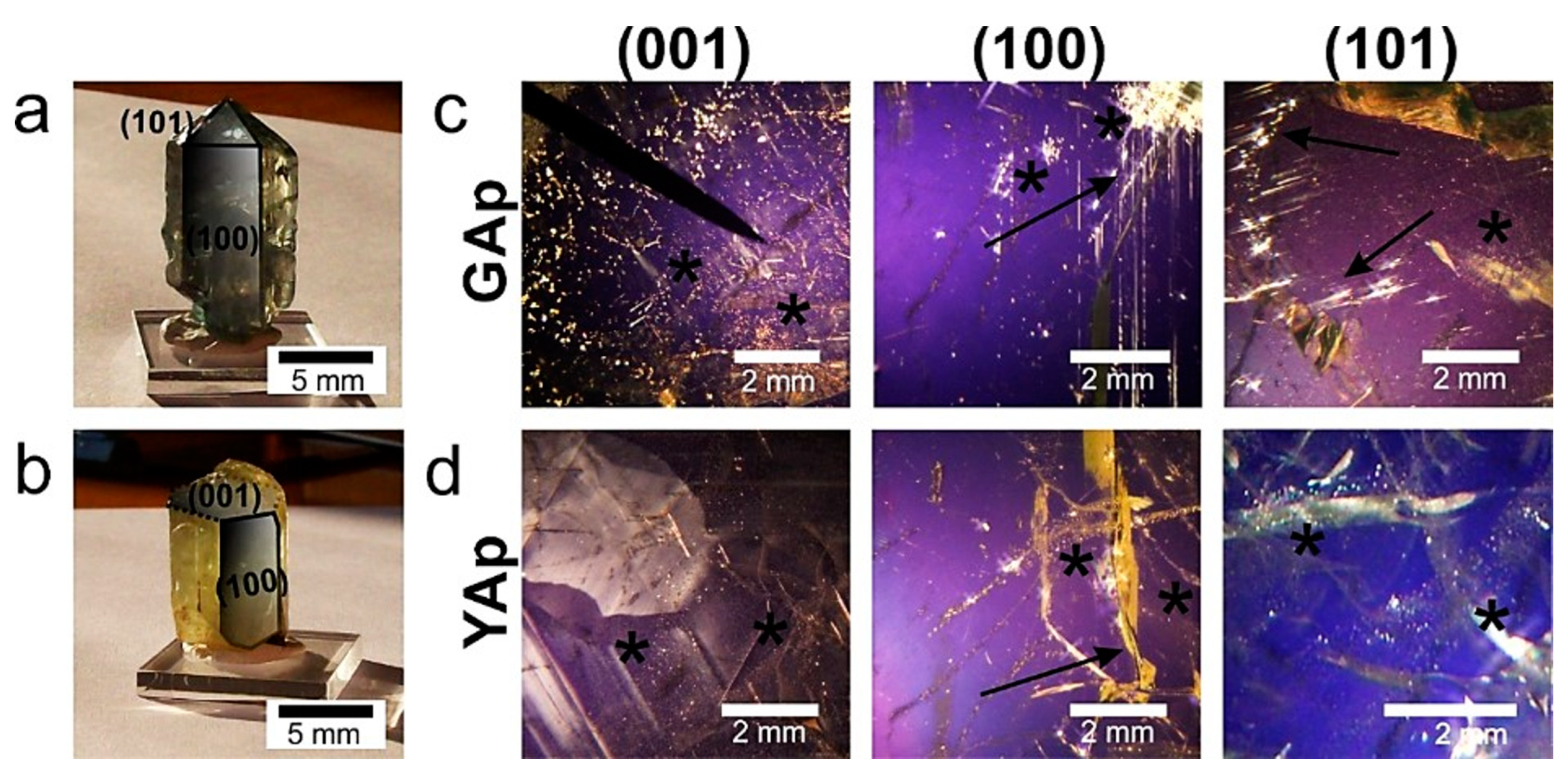

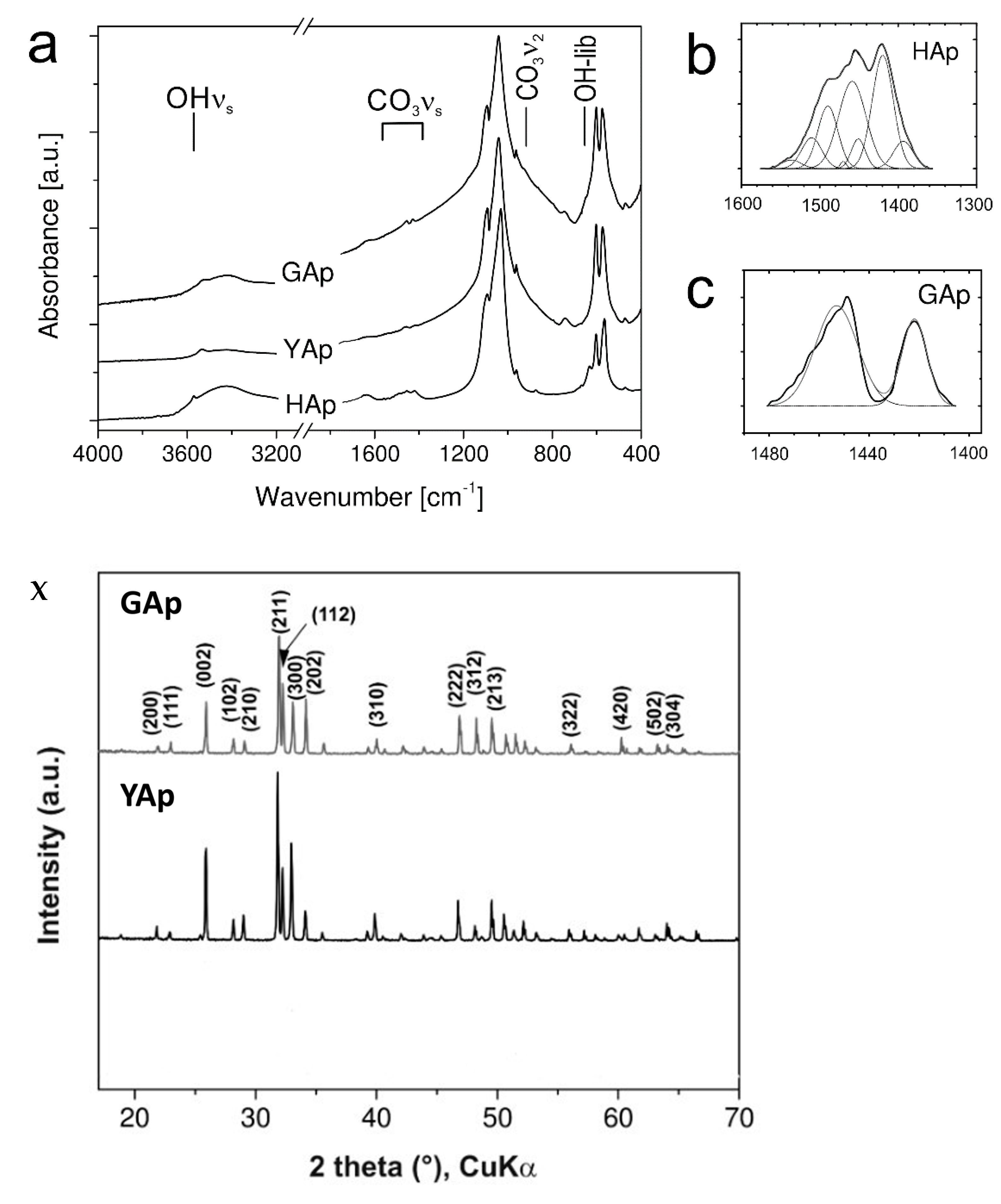
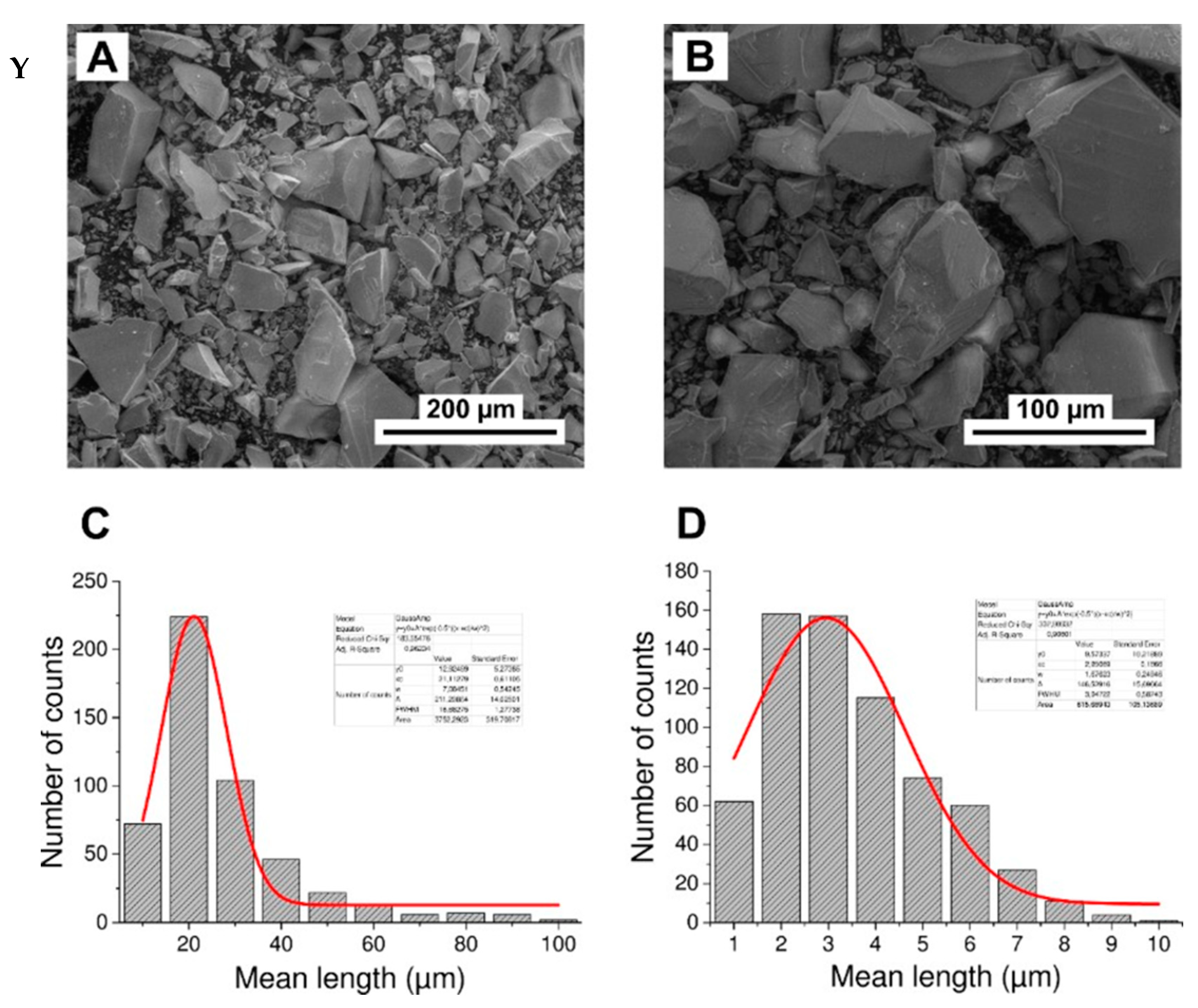
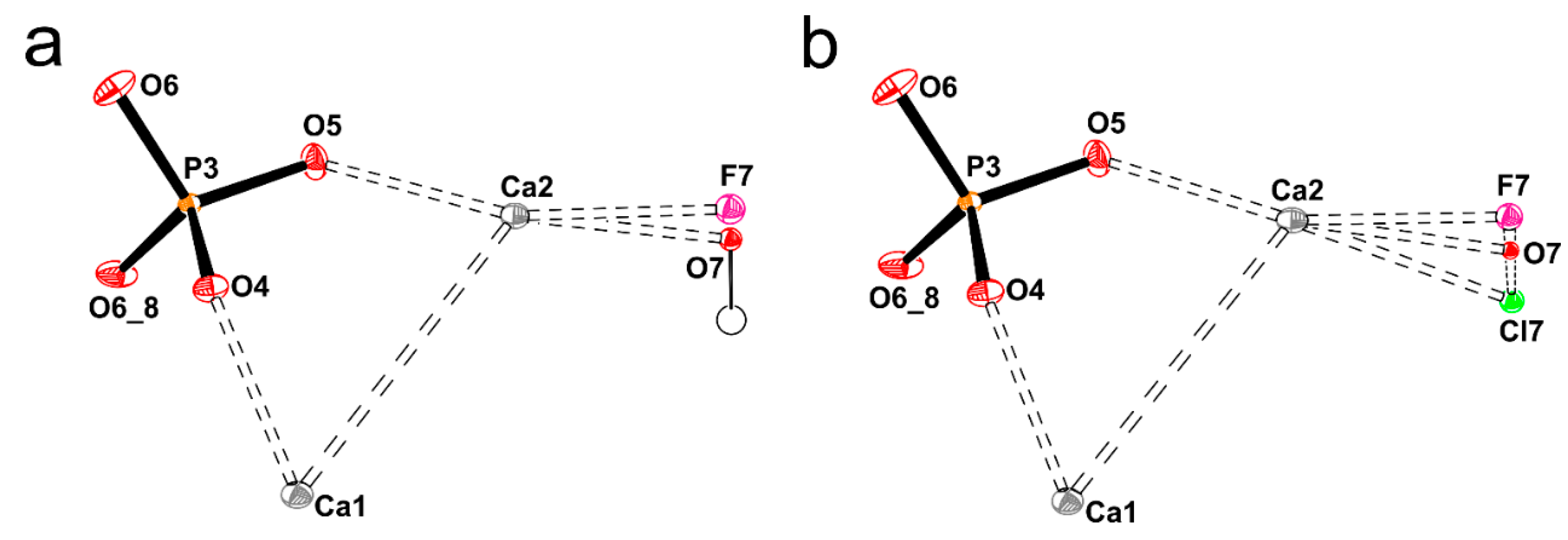
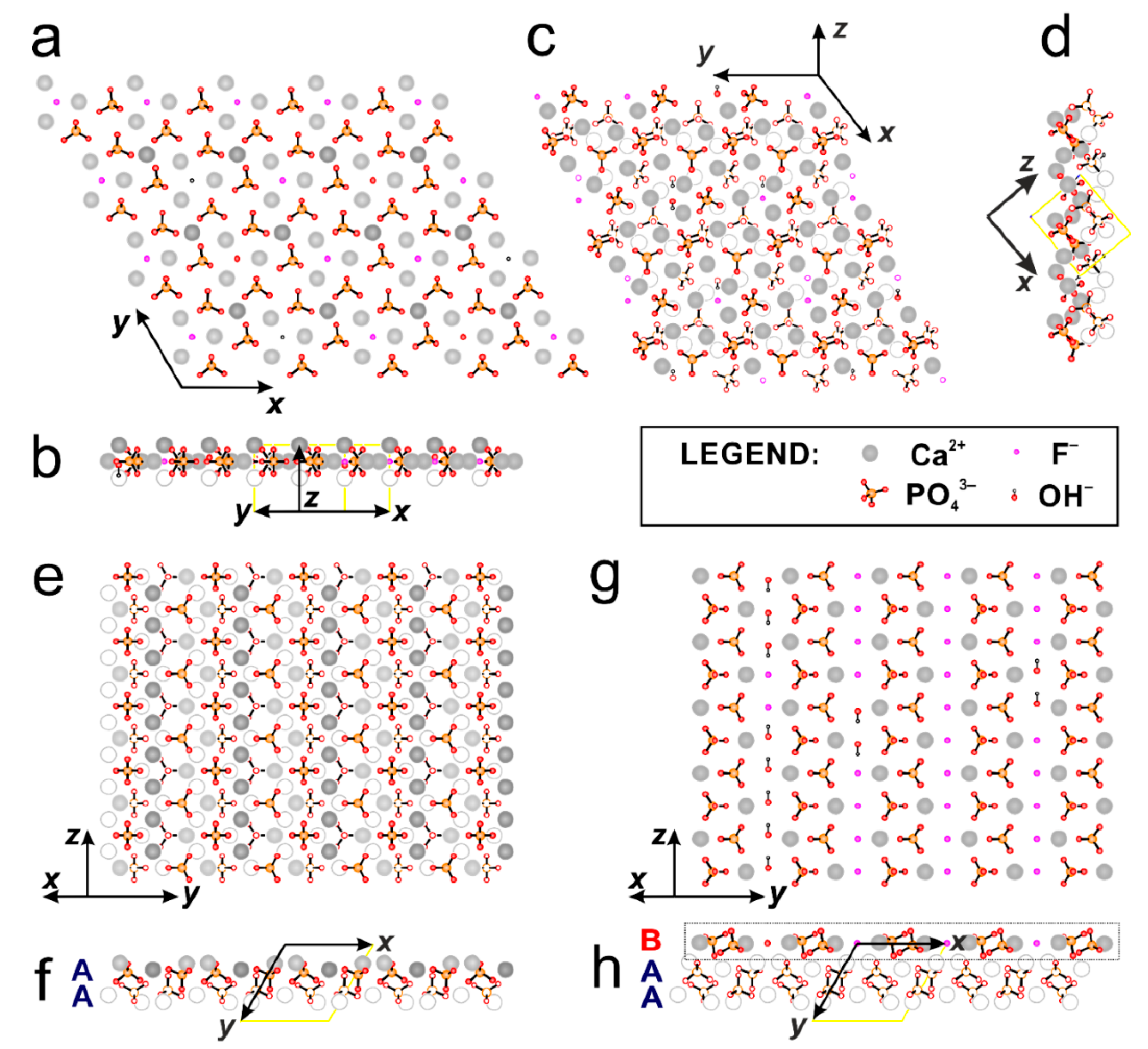
| Apatite Name | Apatite Origin | Chemical Composition | Presence of CO32− | Ca/P Ratio | ||
|---|---|---|---|---|---|---|
| Cations | Anions | Ionic Channels | ||||
| Mineral apatites | ||||||
| GAp | Slyudyanka, Russia | Ca9.41Na0.10Mg0.09 | (PO4)5.55(SiO4)0.28(SO4)0.17 | F1.38(OH)0.62 | traces a | 1.70 |
| YAp | Imilchil, Morocco | Ca9.86 | (PO4)5.87(SiO4)0.13 | F1.22(OH)0.62Cl0.16 | traces a | 1.68 |
| Biological Apatites | ||||||
| E-Apb | enamel | Ca9.52Na0.30Mg0.18 | (PO4)5.85(CO3)0.30 | (OH)1.34(CO3)0.33Cl0.07□0.26 | 3–8 wt% | 1.63 |
| B-Ap c | bone | Ca8.3□1.7 | (PO4)4.3(HPO4 and CO3)1.7 | (OH and/or CO3)0.3□1.7 | --- | <1.67 |
| Mineral Apatites | ||||||
| S-Ap d | Slyudyanka, Russia | Ca9.80Na0.08Mg0.09K0.01 | (PO4)5.88(SiO4)0.01(SO4)0.01 (CO3)0.03 | F1.25(OH)0.73Cl0.03 | <0.1 wt% | 1.67 |
| HAM-Ap e | High Atlas, Morocco | Ca9.90Na0.04Sr0.02 RE0.04 | (PO4)5.80(SiO4)0.10(SO4)0.06 | F1.34(OH)0.56Cl0.10 | none | 1.71 |
| Ca10(PO4)6(OH,F,Cl)2 | GAp Slyudyanka, Russia | YAp Imilchil, Morocco |
|---|---|---|
| Empirical formula | Ca10(PO4)6(F1.38OH0.62) | Ca10(PO4)6(Cl0.05F1.09OH0.86) |
| Formula weight Mr | 1007.38 | 1007.73 |
| Temperature T/K | 293(2) | 293(2) |
| Wavelength λ/Å | 0.71073 | 0.71073 |
| Crystal system | hexagonal | hexagonal |
| Space group * | P 63/m, ITC No176 | P 63/m, ITC No176 |
| Unit cell dimensions/Å,° | a = b = 9.3839(4) c = 6.8867(3) α = β = 90, γ = 120 | a = b = 9.4058(4) c = 6.8807(3) α = β = 90, γ = 120 |
| Unit cell volume V/Å3 | 525.18(4) | 527.17(4) |
| Z; DX/Mg m−3 | 1; 3.185 | 1; 3.174 |
| Absorption coefficient μ/mm−1 | 3.091 | 3.084 |
| F(000) | 500 | 500 |
| Crystal size/mm | 0.30 × 0.19 × 0.15 | 0.45 × 0.30 × 0.18 |
| Absorption corrections | Semi-empirical from equivalents | |
| Max. and Min. transmission | 0.6543, 0.4574 | 0.6067, 0.3375 |
| Theta range θ/° | 3.88 – 29.96 | 3.88 – 27.45 |
| Index ranges | h: 0,14; k: −10,0; l: −9,5 | h: 0,12; k: −10,0; l: −6,8 |
| Reflections collected/symmetrically independent [Rint]/observed [I > 2σ(I)] | 794/548 [Rint = 0.0150] 520 | 616/433 [Rint = 0.0170] 422 |
| Data completeness/% | 99.3 | 98.9 |
| Refinement method | Full-matrix least-squares on F2 | |
| Data/restraints/parameters | 548/0/42 | 433/1/47 |
| S—Goodness-of-fit on F2 | 1.094 | 1.190 |
| Final R indices [I>2σ(I)] | R1 = 0.0191 wR2 = 0.0484 | R1 = 0.0224 wR2 = 0.0556 |
| Final R indices [all data] | R1 = 0.0208 wR2 = 0.0492 | R1 = 0.0230 wR2 = 0.0559 |
| Extinction coefficient | 0.028(3) | 0.090(5) |
| Δρmax, Δρmin, rms/eÅ−3 | 0.364, −0.548, 0.083 | 0.394, −0.850, 0.123 |
| GAp | |||||
| ATOM | Positions | x | y | z | Ueq |
| Ca(1) | 4 f 3. | 0.6667 | 0.3333 | 0.50114(7) | 0.01022(15) |
| Ca(2) | 6 h m. | 0.99278(5) | 0.24217(5) | 0.7500 | 0.00854(14) |
| P(3) | 6 h m. | 1.02934(6) | 0.63108(6) | 0.7500 | 0.00581(15) |
| O(4) | 6 h m. | 0.84261(18) | 0.51609(18) | 0.7500 | 0.0106(3) |
| O(5) | 6 h m. | 1.12065(19) | 0.53326(19) | 0.7500 | 0.0122(3) |
| O(6) | 12 i 1 | 1.08454(13) | 0.74258(13) | 0.92936(16) | 0.0145(3) |
| F(7) | . (0.69) | 1.0000 | 0.0000 | 0.7500 | 0.0104(10) |
| O(7) | 4 e 3. (0.16) | 1.0000 | 0.0000 | 0.692(2) | 0.006(2) |
| H(7) | 4 e 3. (0.16) | 1.0000 | 0.0000 | 0.54(3) | 0.007(3) |
| YAp | |||||
| ATOM | Positions | x | y | z | Ueq |
| Ca(1) | 4 f 3. | −0.3333 | 0.3333 | 0.00132(9) | 0.0099(2) |
| Ca(2) | 6 h m. | −0.00678(6) | 0.24406(6) | 0.2500 | 0.0091(2) |
| P(3) | 6 h m. | 0.02978(8) | 0.63108(8) | 0.2500 | 0.0061(2) |
| O(4) | 6 h m. | −0.1567(2) | 0.5153(2) | 0.2500 | 0.0110(4) |
| O(5) | 6 h m. | 0.1218(2) | 0.5342(2) | 0.2500 | 0.0132(4) |
| O(6) | 12 i 1 | 0.08502(17) | 0.74239(16) | 0.4296(2) | 0.0160(3) |
| F(7) | . (0.54) | 0.0000 | 0.0000 | 0.2500 | 0.0086(18) |
| O(7) | 4 e 3. (0.21) | 0.0000 | 0.0000 | 0.183(3) | 0.0033(19) |
| Cl(7) | 4 e 3. (0.01) | 0.0000 | 0.0000 | 0.083(12) | 0.006(9) |
| GAp | ||||||
| U11 | U22 | U33 | U23 | U13 | U12 | |
| Ca(1) | 0.0121(2) | 0.0121(2) | 0.0065(2) | 0 | 0 | 0.0060(1) |
| Ca(2) | 0.0083(2) | 0.0096(2) | 0.0076(2) | 0 | 0 | 0.0043(2) |
| P(3) | 0.0052(2) | 0.0055(2) | 0.0058(2) | 0 | 0 | 0.0020(2) |
| O(4) | 0.0067(6) | 0.0108(7) | 0.0103(7) | 0 | 0 | 0.0015(6) |
| O(5) | 0.0090(7) | 0.0101(7) | 0.0191(8) | 0 | 0 | 0.0060(6) |
| O(6) | 0.0129(5) | 0.0125(5) | 0.0101(5) | −0.0043(4) | 0.0029(4) | 0.0003(4) |
| YAp | ||||||
| U11 | U22 | U33 | U23 | U13 | U12 | |
| Ca(1) | 0.0117(3) | 0.0117(3) | 0.0063(4) | 0 | 0 | 0.0059(1) |
| Ca(2) | 0.0078(3) | 0.0112(3) | 0.0073(3) | 0 | 0 | 0.0041(2) |
| P(3) | 0.0055(3) | 0.0063(3) | 0.0058(4) | 0 | 0 | 0.0023(2) |
| O(4) | 0.0068(9) | 0.0113(9) | 0.0106(9) | 0 | 0 | 0.0013(7) |
| O(5) | 0.0103(9) | 0.0117(9) | 0.0201(10) | 0 | 0 | 0.0073(8) |
| O(6) | 0.0139(7) | 0.0138(7) | 0.0107(7) | −0.0053(5) | 0.0031(5) | −0.0003(5) |
| BOND | GAp | YAp | |
| Ca(1)-O(4) | 2.4027(11)#1 | 2.4040(13)#1 | |
| Ca(1)-O(4) | 2.4027(11) | 2.4040(13) | |
| Ca(1)-O(4) | 2.4027(11)#2 | 2.4040(13)#2 | |
| Ca(1)-O(5) | 2.4583(11)#3 | 2.4541(14)#3 | |
| Ca(1)-O(5) | 2.4583(11)#4 | 2.4541(14)#4 | |
| Ca(1)-O(5) | 2.4583(11)#5 | 2.4541(14)#5 | |
| Ca(1)-O(6) | 2.8045(12)#6 | 2.8051(15)#6 | |
| Ca(1)-O(6) | 2.8045(12)#7 | 2.8051(15)#7 | |
| Ca(1)-O(6) | 2.8045(12)#8 | 2.8051(15)#8 | |
| Ca(2)-F(7) | 2.3071(4) | 2.3281(5) | |
| Ca(2)-O(7) | 2.342(3) | 2.374(4) | |
| Ca(2)-O(7) | 2.342(3) #9 | 2.374(4) #9 | |
| Ca(2)-Cl(7) | 2.60(4) | ||
| Ca(2)-Cl(7) | 2.60(4) #9 | ||
| Ca(2)-O(6) | 2.3509(11)#6 | 2.3476(14)#10 | |
| Ca(2)-O(6) | 2.3509(11)#10 | 2.3476(14)#11 | |
| Ca(2)-O(5) | 2.3715(16) | 2.3690(19) | |
| Ca(2)-O(6) | 2.4989(11)#11 | 2.5031(13)#6 | |
| Ca(2)-O(6) | 2.4989(11)#12 | 2.5031(13)#12 | |
| Ca(2)-O(4) | 2.6882(17)#1 | 2.705(2) #1 | |
| P(3)-O(6) | 1.5319(11) | 1.5329(14) | |
| P(3)-O(6) | 1.5319(11)#9 | 1.5329(14)#9 | |
| P(3)-O(4) | 1.5310(15) | 1.5337(19) | |
| P(3)-O(5) | 1.5373(16) | 1.5380(19) | |
| Symmetry conditions used to generate symmetrically related atoms: | |||
| GAp | #1 −x + y+1, −x + 1, z | #2 −y + 1, x − y, z | #3 x − y, x − 1, −z + 1 |
| #4 −x + 2, −y + 1, z + 1 | #5 y, −x + y + 1, −z + 1 | #6 −x+2, −y + 1, z − 1/2 | |
| #7 x − y, x − 1, z − 1/2 | #8 y, −x + y + 1, z − 1/2 | #9 x, y, −z + 3/2 | |
| #10 −x + 2, −y + 1, −z + 2 | #11 −y + 2, x − y, z | #12 −y + 2, x − y, −z + 3/2 | |
| YAp | #1 x − y − 1, x, z + 1/2 | #2 y, −x + y + 1, z + 1/2 | #3 −x + y, −x, −z − 1/2 |
| #4 x, y + 1, −z − 1/2 | #5 −y − 1, x − y, −z − 1/2 | #6 −y, x – y + 1, z − 1 | |
| #7 −x, −y, −z − 1 | #8 −x + y − 1, −x, z − 1 | #9 y, −x + y, −z + 1 | |
| #10 y + 1, −x + y, z + 1/2 | #11 x – y + 1, x + 1, −z + 1 | #12 x, y + 1, −z + 1/2 | |
| D-H…A | Position of A | D-H H…A D…A | DHA |
| O(7)-H(7)…O7 | −x + 2, −y, −z + 1 | 1.1(2) 1.6(2) 2.64(3) | 180 |
| O(7)-H(7)…F7 | −x + 2, −y, −z + 1 | 1.1(2) 2.0(2) 3.04(2) | 180 |
| Symmetry conditions used to generate symmetrically related atoms: | |||
| GAp | #1 −x + y + 1, −x + 1, z | #2 −y + 1, x − y, z | #3 x − y, x − 1, −z + 1 |
| #4 −x + 2, −y + 1, z + 1 | #5 y, −x + y + 1, −z + 1 | #6 −x + 2, −y + 1, z − 1/2 | |
| #7 x − y, x − 1, z − 1/2 | #8 y, −x + y + 1, z − 1/2 | #9 x, y, −z + 3/2 | |
| #10 −x + 2, −y + 1, −z + 2 | #11 −y + 2, x − y, z | #12 −y + 2, x − y, −z + 3/2 | |
| YAp | #1 x – y − 1, x, z + 1/2 | #2 y, −x + y + 1, z + 1/2 | #3 −x + y, −x, −z − 1/2 |
| #4 x, y + 1, −z − 1/2 | #5 −y − 1, x − y, −z − 1/2 | #6 −y, x − y + 1, z − 1 | |
| #7 −x, −y, −z − 1 | #8 −x + y−1, −x, z−1 | #9 y, −x + y, −z + 1 | |
| #10 y + 1, −x + y, z + 1/2 | #11 x − y + 1, x + 1, −z + 1 | #12 x, y + 1, −z + 1/2 | |
References
- Cacciotti, I. Multisubstituted Hydroxyapatite Powders and Coatings: The Influence of the Codoping on the Hydroxyapatite Performances. Int. J. Appl. Ceram. Technol. 2019, 16, 1864–1884. [Google Scholar] [CrossRef]
- Haider, A.; Haider, S.; Han, S.S.; Kang, I.K. Recent Advances in the Synthesis, Functionalization and Biomedical Applications of Hydroxyapatite: A Review. RSC Adv. 2017, 7, 7442–7458. [Google Scholar] [CrossRef] [Green Version]
- Arcos, D.; Vallet-Regí, M. Substituted Hydroxyapatite Coatings of Bone Implants. J. Mater. Chem. B 2020, 8, 1781–1800. [Google Scholar] [CrossRef]
- Li, K.; Chen, J.; Xue, Y.; Ding, T.; Zhu, S.; Mao, M.; Zhang, L.; Han, Y. Polymer Brush Grafted Antimicrobial Peptide on Hydroxyapatite Nanorods for Highly Effective Antibacterial Performance. Chem. Eng. J. 2021, 423, 130133. [Google Scholar] [CrossRef]
- Chaudhary, S.; Sharma, P.; Renu; Kumar, R. Hydroxyapatite Doped CeO2 Nanoparticles: Impact on Biocompatibility and Dye Adsorption Properties. RSC Adv. 2016, 6, 62797–62809. [Google Scholar] [CrossRef]
- Turnbull, G.; Clarke, J.; Picard, F.; Riches, P.; Jia, L.; Han, F.; Li, B.; Shu, W. 3D Bioactive Composite Scaffolds for Bone Tissue Engineering. Bioact. Mater. 2018, 3, 278–314. [Google Scholar] [CrossRef] [Green Version]
- Wang, W.; Yeung, K.W.K. Bone Grafts and Biomaterials Substitutes for Bone Defect Repair: A Review. Bioact. Mater. 2017, 2, 224–247. [Google Scholar] [CrossRef]
- Dorozhkin, S.V. Calcium Orthophosphates in Nature, Biology and Medicine. Materials 2009, 2, 399–498. [Google Scholar] [CrossRef] [Green Version]
- Xu, Z.; Xia, Y.; Zhou, P.; Li, J.J.; Yang, M.; Zhang, Y.; Zhang, Y.; Xie, Y.; Li, L.; Pan, H.; et al. Silicon Incorporation into Hydroxyapatite Nanocarrier Counteracts the Side Effects of Vancomycin for Efficient Chronic Osteomyelitis Treatment. Chem. Eng. J. 2021, 406, 126821. [Google Scholar] [CrossRef]
- Maleki-Ghaleh, H.; Hossein Siadati, M.; Fallah, A.; Zarrabi, A.; Afghah, F.; Koc, B.; Dalir Abdolahinia, E.; Omidi, Y.; Barar, J.; Akbari-Fakhrabadi, A.; et al. Effect of Zinc-Doped Hydroxyapatite/Graphene Nanocomposite on the Physicochemical Properties and Osteogenesis Differentiation of 3D-Printed Polycaprolactone Scaffolds for Bone Tissue Engineering. Chem. Eng. J. 2021, 426, 131321. [Google Scholar] [CrossRef]
- Corno, M.; Rimola, A.; Bolis, V.; Ugliengo, P. Hydroxyapatite as a Key Biomaterial: Quantum-Mechanical Simulation of Its Surfaces in Interaction with Biomolecules. Phys. Chem. Chem. Phys. 2010, 12, 6309–6329. [Google Scholar] [CrossRef] [PubMed]
- Vandiver, J.; Dean, D.; Patel, N.; Bonfield, W.; Ortiz, C. Nanoscale Variation in Surface Charge of Synthetic Hydroxyapatite Detected by Chemically and Spatially Specific High-Resolution Force Spectroscopy. Biomaterials 2005, 26, 271–283. [Google Scholar] [CrossRef] [PubMed]
- Kanzaki, N.; Onuma, K.; Ito, A.; Teraoka, K.; Tateishi, T.; Tsutsumi, S. Direct Growth Rate Measurement of Hydroxyapatite Single Crystal by Moire Phase Shift Interferometry. J. Phys. Chem. B 1998, 102, 6471–6476. [Google Scholar] [CrossRef]
- Hagio, T.; Tanase, T.; Akiyama, J.; Umino, M.; Iwai, K.; Asai, S. Difference in Bioactivity, Initial Cell Attachment and Cell Morphology Observed on the Surface of Hydroxyapatite Ceramics with Controlled Orientation. Mater. Trans. 2009, 50, 734–739. [Google Scholar] [CrossRef] [Green Version]
- Inagaki, M.; Kameyama, T. Phase Transformation of Plasma-Sprayed Hydroxyapatite Coating with Preferred Crystalline Orientation. Biomaterials 2007, 28, 2923–2931. [Google Scholar] [CrossRef] [PubMed]
- Vandecandelaere, N.; Rey, C.; Drouet, C. Biomimetic Apatite-Based Biomaterials: On the Critical Impact of Synthesis and Post-Synthesis Parameters. J. Mater. Sci. Mater. Med. 2012, 23, 2593–2606. [Google Scholar] [CrossRef] [Green Version]
- Oyane, A.; Kawashita, M.; Nakanishi, K.; Kokubo, T.; Minoda, M.; Miyamoto, T.; Nakamura, T. Bonelike Apatite Formation on Ethylene-Vinyl Alcohol Copolymer Modified with Silane Coupling Agent and Calcium Silicate Solutions. Biomaterials 2003, 24, 1729–1735. [Google Scholar] [CrossRef]
- Thein-Han, W.W.; Misra, R.D.K. Biomimetic Chitosan-Nanohydroxyapatite Composite Scaffolds for Bone Tissue Engineering. Acta Biomater. 2009, 5, 1182–1197. [Google Scholar] [CrossRef]
- Wang, Y.; Hassan, M.S.; Gunawan, P.; Lau, R.; Wang, X.; Xu, R. Polyelectrolyte Mediated Formation of Hydroxyapatite Microspheres of Controlled Size and Hierarchical Structure. J. Colloid Interface Sci. 2009, 339, 69–77. [Google Scholar] [CrossRef]
- Zhai, Y.; Cui, F.Z. Recombinant Human-like Collagen Directed Growth of Hydroxyapatite Nanocrystals. J. Cryst. Growth 2006, 291, 202–206. [Google Scholar] [CrossRef]
- Kikuchi, M.; Ikoma, T.; Itoh, S.; Matsumoto, H.N.; Koyama, Y.; Takakuda, K.; Shinomiya, K.; Tanaka, J. Biomimetic Synthesis of Bone-like Nanocomposites Using the Self-Organization Mechanism of Hydroxyapatite and Collagen. Compos. Sci. Technol. 2004, 64, 819–825. [Google Scholar] [CrossRef]
- Venegas, S.C.; Palacios, J.M.; Apella, M.C.; Morando, P.J.; Blesa, M.A. Calcium Modulates Interactions between Bacteria and Hydroxyapatite. J. Dent. Res. 2006, 85, 1124–1128. [Google Scholar] [CrossRef]
- Dai, C.; Duan, J.; Zhang, L.; Jia, G.; Zhang, C.; Zhang, J. Biocompatibility of Defect-Related Luminescent Nanostructured and Microstructured Hydroxyapatite. Biol. Trace Elem. Res. 2014, 162, 158–167. [Google Scholar] [CrossRef] [PubMed]
- García-Tuñón, E.; Couceiro, R.; Franco, J.; Saiz, E.; Guitián, F. Synthesis and Characterisation of Large Chlorapatite Single-Crystals with Controlled Morphology and Surface Roughness. J. Mater. Sci. Mater. Med. 2012, 23, 2471–2482. [Google Scholar] [CrossRef] [PubMed] [Green Version]
- Eslami, H.; Solati-Hashjin, M.; Tahriri, M. The Comparison of Powder Characteristics and Physicochemical, Mechanical and Biological Properties between Nanostructure Ceramics of Hydroxyapatite and Fluoridated Hydroxyapatite. Mater. Sci. Eng. C 2009, 29, 1387–1398. [Google Scholar] [CrossRef]
- Lehmann, G.; Cacciotti, I.; Palmero, P.; Montanaro, L.; Bianco, A.; Campagnolo, L.; Camaioni, A. Differentiation of Osteoblast and Osteoclast Precursors on Pure and Silicon-Substituted Synthesized Hydroxyapatites. Biomed. Mater. 2012, 7, 055001. [Google Scholar] [CrossRef]
- Balamurugan, A.; Rebelo, A.H.S.; Lemos, A.F.; Rocha, J.H.G.; Ventura, J.M.G.; Ferreira, J.M.F. Suitability Evaluation of Sol-Gel Derived Si-Substituted Hydroxyapatite for Dental and Maxillofacial Applications through in Vitro Osteoblasts Response. Dent. Mater. 2008, 24, 1374–1380. [Google Scholar] [CrossRef] [PubMed]
- Grandjean-Laquerriere, A.; Laquerriere, P.; Jallot, E.; Nedelec, J.M.; Guenounou, M.; Laurent-Maquin, D.; Phillips, T.M. Influence of the Zinc Concentration of Sol-Gel Derived Zinc Substituted Hydroxyapatite on Cytokine Production by Human Monocytes in Vitro. Biomaterials 2006, 27, 3195–3200. [Google Scholar] [CrossRef] [Green Version]
- Capuccini, C.; Torricelli, P.; Sima, F.; Boanini, E.; Ristoscu, C.; Bracci, B.; Socol, G.; Fini, M.; Mihailescu, I.N.; Bigi, A. Strontium-Substituted Hydroxyapatite Coatings Synthesized by Pulsed-Laser Deposition: In Vitro Osteoblast and Osteoclast Response. Acta Biomater. 2008, 4, 1885–1893. [Google Scholar] [CrossRef]
- Kannan, S.; Vieira, S.I.; Olhero, S.M.; Torres, P.M.C.; Pina, S.; Da Cruz E Silva, O.A.B.; Ferreira, J.M.F. Synthesis, Mechanical and Biological Characterization of Ionic Doped Carbonated Hydroxyapatite/β-Tricalcium Phosphate Mixtures. Acta Biomater. 2011, 7, 1835–1843. [Google Scholar] [CrossRef]
- Tredwin, C.J.; Young, A.M.; Abou Neel, E.A.; Georgiou, G.; Knowles, J.C. Hydroxyapatite, Fluor-Hydroxyapatite and Fluorapatite Produced via the Sol-Gel Method: Dissolution Behaviour and Biological Properties after Crystallisation. J. Mater. Sci. Mater. Med. 2014, 25, 47–53. [Google Scholar] [CrossRef] [PubMed] [Green Version]
- Cheng, K.; Weng, W.; Wang, H.; Zhang, S. In Vitro Behavior of Osteoblast-like Cells on Fluoridated Hydroxyapatite Coatings. Biomaterials 2005, 26, 6288–6295. [Google Scholar] [CrossRef] [PubMed]
- Vennat, E.; Denis, M.; David, B.; Attal, J.P. A Natural Biomimetic Porous Medium Mimicking Hypomineralized Enamel. Dent. Mater. 2015, 31, 225–234. [Google Scholar] [CrossRef] [PubMed]
- Paine, M.L.; Snead, M.L. Tooth Developmental Biology: Disruptions to Enamel-Matrix Assembly and Its Impact on Biomineralization. Orthod. Craniofacial Res. 2005, 8, 239–251. [Google Scholar] [CrossRef] [PubMed]
- Sibilla, P.; Sereni, A.; Aguiari, G.; Banzi, M.; Manzati, E.; Mischiati, C.; Trombelli, L.; Del Senno, L. Effects of a Hydroxyapatite-Based Biomaterial on Gene Expression in Osteoblast-like Cells. J. Dent. Res. 2006, 85, 354–358. [Google Scholar] [CrossRef]
- Alshemary, A.Z.; Goh, Y.F.; Akram, M.; Razali, I.R.; Abdul Kadir, M.R.; Hussain, R. Microwave Assisted Synthesis of Nano Sized Sulphate Doped Hydroxyapatite. Mater. Res. Bull. 2013, 48, 2106–2110. [Google Scholar] [CrossRef]
- Pan, Y.; Fleet, M.E. Compositions of the Apatite-Group Minerals: Substitution Mechanisms and Controlling Factors. Phosphates Geochem. Geobiol. Mater. Importance 2019, 48, 13–50. [Google Scholar] [CrossRef]
- Koutsopoulos, S. Synthesis and Characterization of Hydroxyapatite Crystals: A Review Study on the Analytical Methods. J. Biomed. Mater. Res. 2002, 62, 600–612. [Google Scholar] [CrossRef]
- Fleet, M.E.; Liu, X. Coupled Substitution of Type A and B Carbonate in Sodium-Bearing Apatite. Biomaterials 2007, 28, 916–926. [Google Scholar] [CrossRef]
- Fleet, M.E. Infrared Spectra of Carbonate Apatites: Ν2-Region Bands. Biomaterials 2009, 30, 1473–1481. [Google Scholar] [CrossRef]
- Astala, R.; Stott, M.J. First-Principles Study of Hydroxyapatite Surfaces and Water Adsorption. Phys. Rev. B 2008, 78, 075427. [Google Scholar] [CrossRef]
- Pastero, L.; Bruno, M.; Aquilano, D. About the Genetic Mechanisms of Apatites: A Survey on the Methodological Approaches. Minerals 2017, 7, 139. [Google Scholar] [CrossRef] [Green Version]
- Harding, I.S.; Rashid, N.; Hing, K.A. Surface Charge and the Effect of Excess Calcium Ions on the Hydroxyapatite Surface. Biomaterials 2005, 26, 6818–6826. [Google Scholar] [CrossRef] [PubMed]
- Hunter, G.K.; O’Young, J.; Grohe, B.; Karttunen, M.; Goldberg, H.A. The Flexible Polyelectrolyte Hypothesis of Protein−Biomineral Interaction. Langmuir 2010, 26, 18639–18646. [Google Scholar] [CrossRef]
- Dubiel, E.A.; Martin, Y.; Vermette, P. Bridging the Gap between Physicochemistry and Interpretation Prevalent in Cell−Surface Interactions. Chem. Rev. 2011, 111, 2900–2936. [Google Scholar] [CrossRef]
- Zelzer, M.; Albutt, D.; Alexander, M.R.; Russell, N.A. The Role of Albumin and Fibronectin in the Adhesion of Fibroblasts to Plasma Polymer Surfaces. Plasma Processes Polym. 2012, 9, 149–156. [Google Scholar] [CrossRef]
- Liu, Z.-S.; Tang, S.-L.; Ai, Z.-L. Effects of Hydroxyapatite Nanoparticles on Proliferation and Apoptosis of Human Hepatoma BEL-7402 Cells. World J. Gastroenterol. 2003, 9, 1968–1971. [Google Scholar] [CrossRef]
- Barbier, O.; Arreola-Mendoza, L.; Del Razo, L.M. Molecular Mechanisms of Fluoride Toxicity. Chem.-Biol. Interact. 2010, 188, 319–333. [Google Scholar] [CrossRef]
- Eliaz, N.; Sridhar, T.M. Electrocrystallization of Hydroxyapatite and Its Dependence on Solution Conditions. Cryst. Growth Des. 2008, 8, 3965–3977. [Google Scholar] [CrossRef]
- Faghihi, S.; Azari, F.; Szpunar, J.A.; Vali, H.; Tabrizian, M. Titanium Crystal Orientation as a Tool for the Improved and Regulated Cell Attachment. J. Biomed. Mater. Res. Part A 2009, 91, 656–662. [Google Scholar] [CrossRef]
- Keikhosravani, P.; Maleki-Ghaleh, H.; Kahaie Khosrowshahi, A.; Bodaghi, M.; Dargahi, Z.; Kavanlouei, M.; Khademi-Azandehi, P.; Fallah, A.; Beygi-Khosrowshahi, Y.; Siadati, M.H. Bioactivity and Antibacterial Behaviors of Nanostructured Lithium-Doped Hydroxyapatite for Bone Scaffold Application. Int. J. Mol. Sci. 2021, 22, 9214. [Google Scholar] [CrossRef]
- Borkowski, L.; Przekora, A.; Belcarz, A.; Palka, K.; Jojczuk, M.; Lukasiewicz, P.; Nogalski, A.; Ginalska, G. Highly Porous Fluorapatite/β-1,3-Glucan Composite for Bone Tissue Regeneration: Characterization and In-Vitro Assessment of Biomedical Potential. Int. J. Mol. Sci. 2021, 22, 10414. [Google Scholar] [CrossRef] [PubMed]
- Buchloh, S.; Stieger, B.; Meier, P.J.; Gauckler, L. Hepatocyte Performance on Different Crystallographic Faces of Rutile. Biomaterials 2003, 24, 2605–2610. [Google Scholar] [CrossRef]
- Suzuki, K.; Fukasawa, J.; Miura, M.; Lim, P.N.; Honda, M.; Matsuura, T.; Aizawa, M. Influence of Culture Period on Osteoblast Differentiation of Tissue-Engineered Bone Constructed by Apatite-Fiber Scaffolds Using Radial-Flow Bioreactor. Int. J. Mol. Sci. 2021, 22, 13080. [Google Scholar] [CrossRef] [PubMed]
- Olivier, F.; Bonnamy, S.; Rochet, N.; Drouet, C. Activated Carbon Fiber Cloth/Biomimetic Apatite: A Dual Drug Delivery System. Int. J. Mol. Sci. 2021, 22, 12247. [Google Scholar] [CrossRef] [PubMed]
- Altomare, A.; Cascarano, G.; Giacovazzo, C.; Guagliardi, A.; Burla, M.C.; Polidori, G.; Camalli, M. IUCr SIR92—A Program for Automatic Solution of Crystal Structures by Direct Methods. J. Appl. Crystallogr. 1994, 27, 435. [Google Scholar] [CrossRef]
- Sheldrick, G.M. A Short History of SHELX. Acta Cryst. 2007, 64, 112–122. [Google Scholar] [CrossRef] [PubMed] [Green Version]
- Farrugia, L.J. ORTEP-3 for Windows—A Version of ORTEP-III with a Graphical User Interface (GUI). J. Appl. Crystallogr. 1997, 30, 565. [Google Scholar] [CrossRef]
- Kotobuki, N.; Ioku, K.; Kawagoe, D.; Fujimori, H.; Goto, S.; Ohgushi, H. Observation of Osteogenic Differentiation Cascade of Living Mesenchymal Stem Cells on Transparent Hydroxyapatite Ceramics. Biomaterials 2005, 26, 779–785. [Google Scholar] [CrossRef]
- Chou, Y.F.; Huang, W.; Dunn, J.C.Y.; Miller, T.A.; Wu, B.M. The Effect of Biomimetic Apatite Structure on Osteoblast Viability, Proliferation, and Gene Expression. Biomaterials 2005, 26, 285–295. [Google Scholar] [CrossRef]
- Pasko, P.; Bukowska-Strakova, K.; Gdula-Argasinska, J.; Tyszka-Czochara, M. Rutabaga (Brassica Napus L. Var. Napobrassica) Seeds, Roots, and Sprouts: A Novel Kind of Food with Antioxidant Properties and Proapoptotic Potential in Hep G2 Hepatoma Cell Line. J. Med. Food 2013, 16, 749–759. [Google Scholar] [CrossRef]
- Simmer, J.P.; Fincham, A.G. Molecular Mechanisms of Dental Enamel Formation. Crit. Rev. Oral Biol. Med. 1995, 6, 84–108. [Google Scholar] [CrossRef] [PubMed] [Green Version]
- Cazalbou, S.; Combes, C.; Eichert, D.; Rey, C. Adaptative physico-chemistry of bio-related calcium phosphates. J. Mater. Chem. 2004, 14, 2148–2153. [Google Scholar] [CrossRef]
- Chaikina, M.V.; Aman, S. Fracture, Grinding, Mechanical Activation and Synthesis Processes in Solids under Mechanical Action. Sci. Sinter. 2005, 37, 93–105. [Google Scholar] [CrossRef]
- Henderson, C.E. Protocols and Pitfalls of Electron Microprobe Analysis of Apatite. Master’s Thesis, The University of Michigan, Ann Arbor, MI, USA, 2011. [Google Scholar]
- International Union of Crystallography. International Tables for Crystallography, Volume A: Space-Group Symmetry, 5th ed.; corrected reprint; Hahn, T., Ed.; Springer: Berlin/Heidelberg, Germany, 2005; pp. 564–565. [Google Scholar]

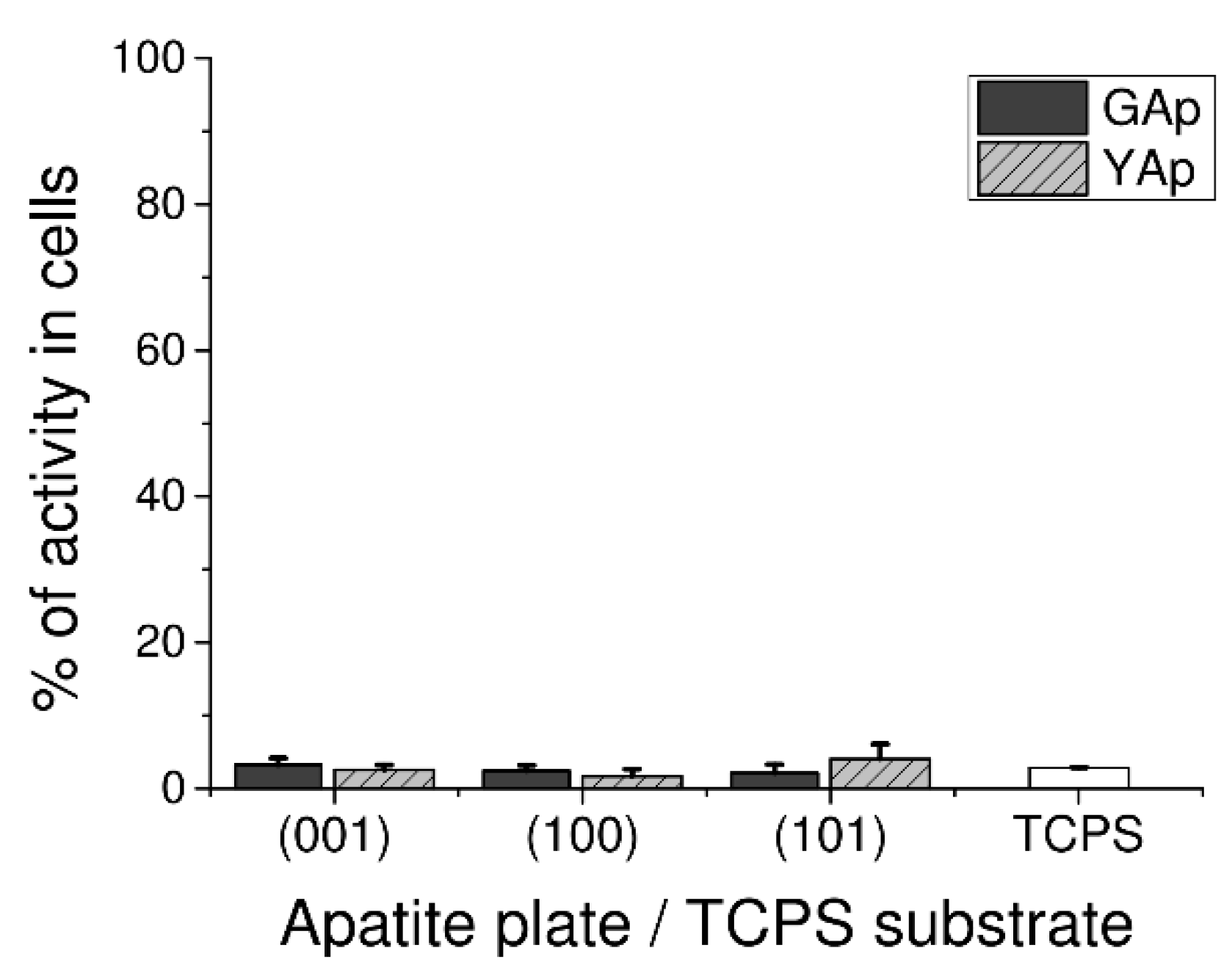
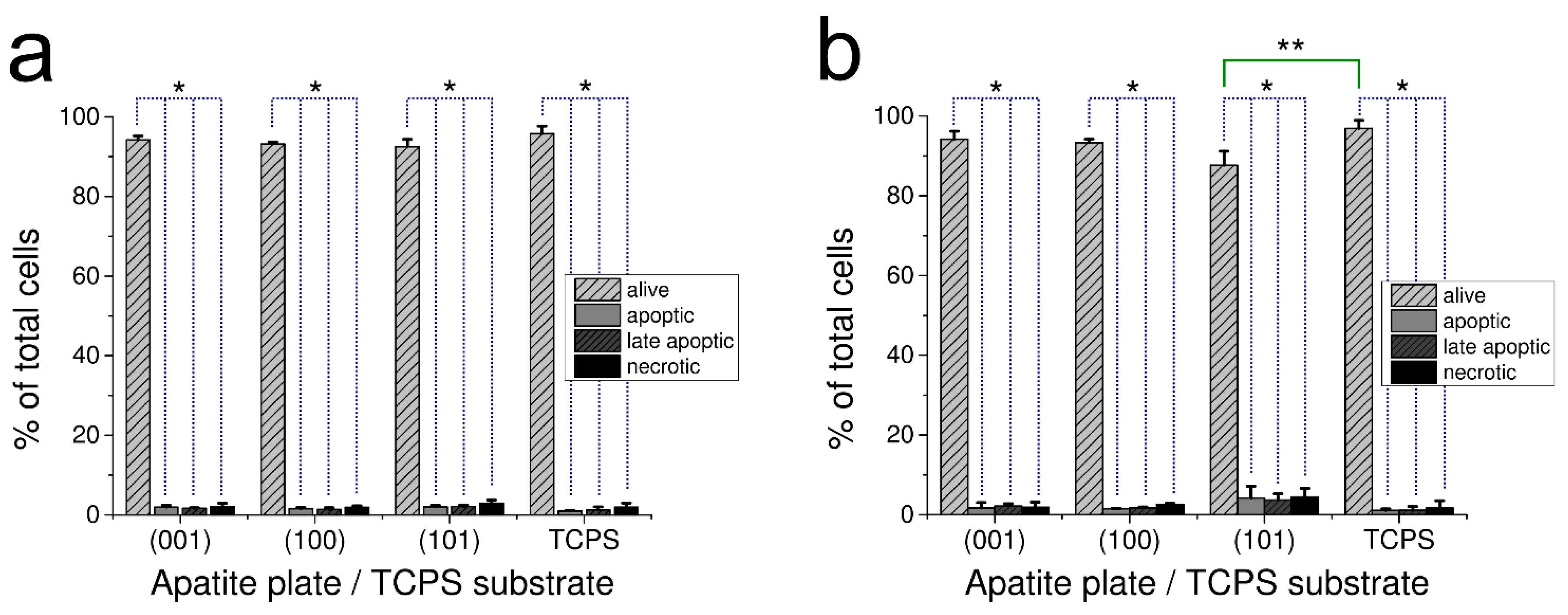
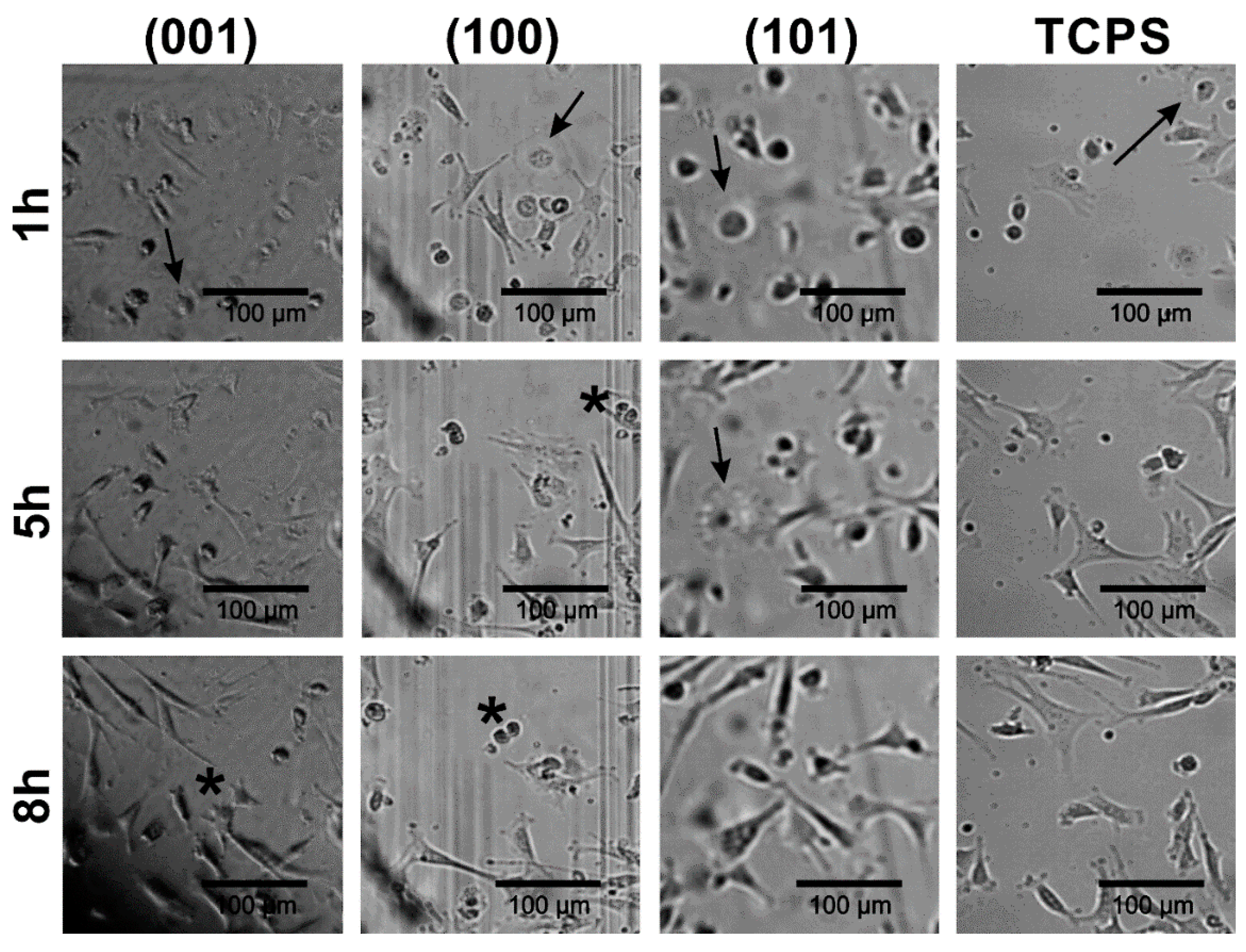
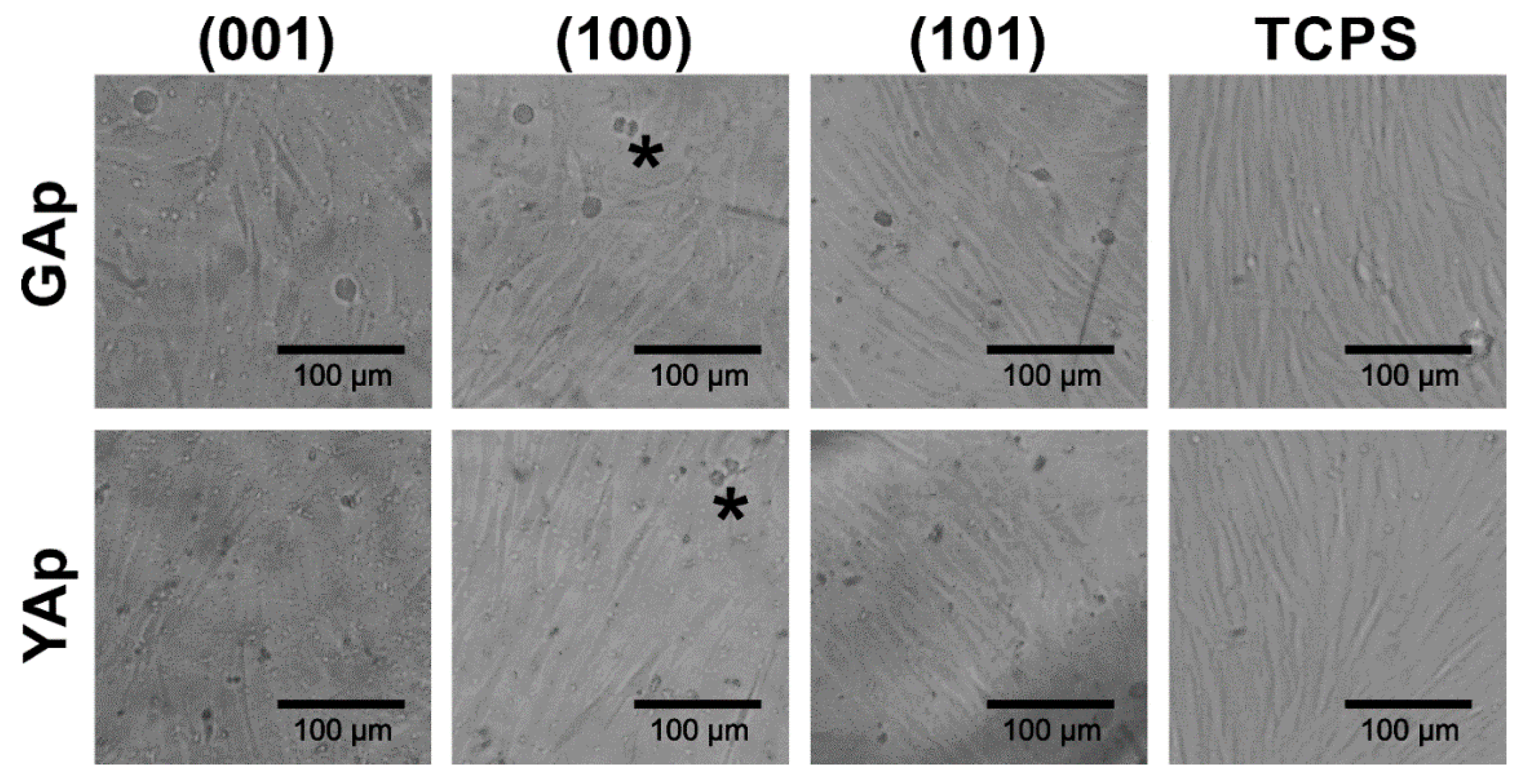
| Chemical Element | HAp wt.% | GAp * wt% | YAp ** wt% | ||||||
|---|---|---|---|---|---|---|---|---|---|
| (001) | (100) | (101) | Mean | (001) | (100) | (101) | Mean | ||
| Ca | 39.9 | 38.3 | 36.9 | 41.8 | 39.0 | 40.8 | 41.3 | 40.5 | 40.9 |
| P | 18.5 | 18.5 | 17.7 | 16.6 | 17.6 | 17.2 | 17.1 | 17.3 | 17.2 |
| F | 2.7 | 6.2 | 2.0 | 3.6 | 2.3 | 2.0 | 2.9 | 2.4 | |
| Cl | – | – | – | – | 0.7 | 0.7 | 0.6 | 0.7 | |
| Si | 0.7 | 0.6 | 0.9 | 0.7 | 0.5 | 0.3 | 0.2 | 0.3 | |
| S | 0.6 | 0.9 | 0.6 | 0.7 | – | – | – | – | |
| O | 41.4 | 39.2 | 37.7 | 38.1 | 38.4 | 38.5 | 38.6 | 38.5 | 38.5 |
| H | 0.2 | ||||||||
| Type of Surface | Estimated Time of Cell Detachment (min) | ||
|---|---|---|---|
| Enzymatic System | Non-Enzymatic System | Versenate | |
| TCPS | 5 ± 2 a | 3 ± 1 a | 10 ± 5 a |
| GAp | 12 ± 3 b | 7 ± 2 b | 24 ± 5 b |
| YAp | 12 ± 3 b | 8 ± 3 b | 23 ± 5 b |
| Apatite Crystal Face | OH−/F−/Cl− | Ca2+ | PO43− | Resultant Charge | No of OH−/F−/Cl−/1000 nm2 | |
|---|---|---|---|---|---|---|
| GAp | YAp | |||||
| (001) | 1 | 4 | 3 | 2− | 406/905/--- | 561/711/33 |
| (101) | 1.5 | 7 | 4 | 1.5+ | 580/1291/--- | 805/1020/46 |
| (100) A | --- | 4 | 2 | 2+ | --- | --- |
| (100) B | 2 | 2 | 2 | 4− | 959/2136/--- | 1329/1685/77 |
Publisher’s Note: MDPI stays neutral with regard to jurisdictional claims in published maps and institutional affiliations. |
© 2022 by the authors. Licensee MDPI, Basel, Switzerland. This article is an open access article distributed under the terms and conditions of the Creative Commons Attribution (CC BY) license (https://creativecommons.org/licenses/by/4.0/).
Share and Cite
Tyszka-Czochara, M.; Suder, M.; Dołhańczuk-Śródka, A.; Rajfur, M.; Grata, K.; Starosta, M.; Jagoda-Pasternak, A.; Kasprzyk, W.; Nowak, A.K.; Ahmadzadeh, S.; et al. Nature-Inspired Effects of Naturally Occurring Trace Element-Doped Hydroxyapatite Combined with Surface Interactions of Mineral-Apatite Single Crystals on Human Fibroblast Behavior. Int. J. Mol. Sci. 2022, 23, 802. https://doi.org/10.3390/ijms23020802
Tyszka-Czochara M, Suder M, Dołhańczuk-Śródka A, Rajfur M, Grata K, Starosta M, Jagoda-Pasternak A, Kasprzyk W, Nowak AK, Ahmadzadeh S, et al. Nature-Inspired Effects of Naturally Occurring Trace Element-Doped Hydroxyapatite Combined with Surface Interactions of Mineral-Apatite Single Crystals on Human Fibroblast Behavior. International Journal of Molecular Sciences. 2022; 23(2):802. https://doi.org/10.3390/ijms23020802
Chicago/Turabian StyleTyszka-Czochara, Malgorzata, Marzena Suder, Agnieszka Dołhańczuk-Śródka, Małgorzata Rajfur, Katarzyna Grata, Michał Starosta, Agnieszka Jagoda-Pasternak, Wiktor Kasprzyk, Anna K. Nowak, Saeid Ahmadzadeh, and et al. 2022. "Nature-Inspired Effects of Naturally Occurring Trace Element-Doped Hydroxyapatite Combined with Surface Interactions of Mineral-Apatite Single Crystals on Human Fibroblast Behavior" International Journal of Molecular Sciences 23, no. 2: 802. https://doi.org/10.3390/ijms23020802
APA StyleTyszka-Czochara, M., Suder, M., Dołhańczuk-Śródka, A., Rajfur, M., Grata, K., Starosta, M., Jagoda-Pasternak, A., Kasprzyk, W., Nowak, A. K., Ahmadzadeh, S., Kopeć, D., Suryło, P., Świergosz, T., & Stadnicka, K. M. (2022). Nature-Inspired Effects of Naturally Occurring Trace Element-Doped Hydroxyapatite Combined with Surface Interactions of Mineral-Apatite Single Crystals on Human Fibroblast Behavior. International Journal of Molecular Sciences, 23(2), 802. https://doi.org/10.3390/ijms23020802









